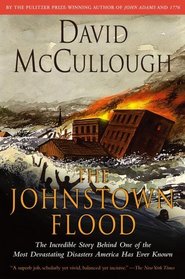Helpful Score: 1
An amazing book about one of the worst disasters in American history.
Helpful Score: 1
A very well written book regarding the biggest natural disaster in American history. It could have been a fictional novel the way it is written and the immense tragedy that bestowed the people of Johnstown PA. It is certainly more interesting if you are familar with the area. A good non fiction read.
Helpful Score: 1
I read this book for one of my book clubs.I learned a lot about this town and the flood that happened.I still think about this book even though I read it a while ago.It was very informative and I couldn't put the book down.I never knew that much about the flood until I read this book.I highly recommend it.It also gives you history on the town also and the people who lived there.
Helpful Score: 1
Interesting from both an historical, meteorlogical and sociological Perspective...could not put it down...
Reallly fine "nonfiction thriller" about the buildup to the worst natural disaster ever in the USA. Great texture and mood--reads more like a novel.
Great book for any American history buff. The lives of the famous (Andrew Carnegie and Clara Barton) and not famous are richly related and will keep you wanting to discover their fate. The heroism is detailed and some myths debunked. It's a terrific read not only for the history lover but for anyone who enjoys a good novel.
The natural disasters in September 2005 hurricane season sadly enough make this book really topical and relevant. More than 2,000 people died in the 1889 Johnstown Flood because they had no warning that a dam had broken high up in the hills. But this famous disaster also was an occasion for shining displays of heroism by ordinary people. (Do not miss the account of the train's engineer trying to outrace the flood waters.) Also, the aftermath was the first opportunity for Clara Barton's newly organized Red Cross to prove its mettle. David McCullough's narrative is novelistic and riveting. If you've never read him before, this is an excellent book to start with. The first few chapters -- which discuss the earthen dam that was built by an exclusive social club of Pittsburgh millionaires -- are slower going, but try to stick with them. You'll want to remember this part, in later chapters, when the disaster's over and the stunned American public of 1889 begins to ask: "Why? Who's to blame?" As for the narrative of the flood itself, I guarantee you that, once the flood waters hit Johnstown, you will be rooting for all the townspeople you've come to care for, and you will not be able to put this book down.
I read this in the context of the recent Katrina disaster. It's interesting to contrast the expectations 100 years ago (no FEMA) and the rapidity with which ordinary citizens organized aid (within hours). An excellent historian -- well-researched, interspersed with the more credible personal accounts.
Very detailed, perhaps to a fault, but a good read for the history buff. You have to be impressed with the extent of the author's research.
This is the the riveting story of one of this country's most horrendous natural disasters as only David McCullough can tell it.
Extremely well-read, unabridged, detailed, haunting account of our nation's worst flood disaster. Six cassettes.
David McCullough can bring history to life so vividly. I could not put it down, even when it was past my bedtime. I did struggle a little keeping the individuals straight, but I consider that a side-effect of reading too fast to get to the next page.
This book was hard to put down.
Full of great details and facts, but easy to read. I would reccomended it to anyone who is interested in educating themselves more on US history.
Full of great details and facts, but easy to read. I would reccomended it to anyone who is interested in educating themselves more on US history.
This book is used at Rensselaer as well as in the civil engineering classes at other colleges. See the excellent review by Margaret M. Mitchell, One Book, Four Subjects in December 2017 Civil Engineering page 20. "Although the book is a story of devastation and loss, it is an unconventional-yet ideal-springboard for students as they em bark on their study of four of the main branches of civil engineering: environmental, geotechnical, structural, and transportation."




![header=[] body=[Get a free book credit right now by joining the club and listing 5 books you have and are willing to share with other members!] Help icon](/images/question.gif?v=90afaeb39)
